.
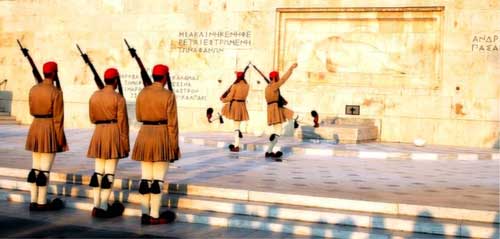
The Evzones, or Euzones, (Greek: Εύζωνοι, the Well-Girt) is a name for several historical elite light infantry and mountain battalions and regiments of the Greek Army. Today, it refers to the members of the Proedriki Froura (Presidential Guard), an elite ceremonial unit that guards the Greek Parliament and Presidential Mansion.
The unit is famous around the world for its unique traditional uniform which is designed to be similar to the outfits worn by the klephts who fought the Ottoman occupation of Greece. Part of this uniform is fustanella, a kilt-like garment.
History
The first Evzones unit was formed in 1868 as the royal guard (Ευζώνη—Evzone—, literally "Well-Girt," an ancient Greek phrase dating to Homer), and continued its role after the abolition of the Greek monarchy. At their height, the evzones comprised five regiments and were considered the elite of the Hellenic Army. As such, they were frequently used as shock troops. The units suffered horrific casualties in the Balkan and world wars, and were disbanded in 1944 save for the ceremonial guard unit.
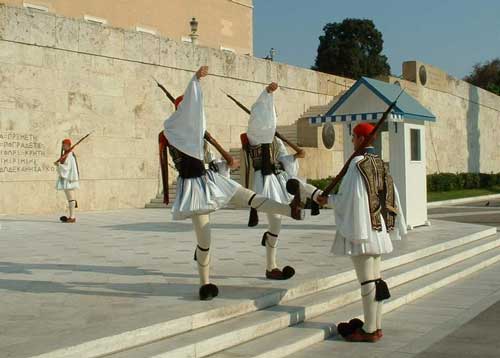
Present role
Today the regiment is purely ceremonial, with duties including:
Guarding, on a 24-hour basis, the Tomb of the Unknown Soldier, the Presidential Mansion and the gates of the Presidential Guard training camp.
The official raising and lowering of the flag (at 9am and 6pm respectively) every Sunday at the Acropolis
Accompanying the President of the Hellenic Democracy on official foreign visits
Offering honours and welcoming foreign officials on visit
An annual Parade on New York’s 5th Avenue in celebration of Greece’s March 25th National Day
Accompanying the Holy Fire every Easter from Jerusalem to Athens
The Proedriki Froura are billeted in the George Tzavellas Barracks, on Herodes Atticus Street in Athens, near the Presidential Mansion.
German "Evzones"
During World War II, the occupying German forces raised Evzones regiments attired in the traditional tsolias costume of the regiments, but reporting to the German authorities. These were widely reviled in colloquial Greek as Germanotsoliades.
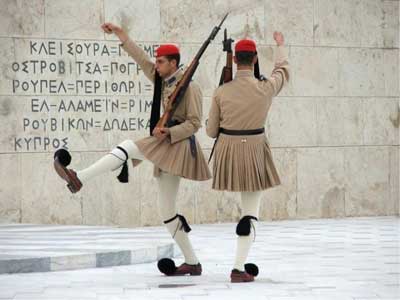
Former Units
The historical units were numbered and known as Τάγμα Ευζώνων - "Tagma (Battalion) of Evzones" - or Σύνταγμα - "Regiment of Evzones." The names are usually translated in English-language works with "Evzones" as an adjective modifying the unit, instead of a possesive plural, which is a more accurate reflection of the original Greek. Since the regiments were distinctive, elite units, they had dual numbers - the first, numbering them in the Evzones hierarchy, the second, in the overall infantry hierarchy. Thus the 5/42 Evzones Regiment was the 5th Regiment of Evzones, but also the 42nd Regiment of Infantry.
1/38 Evzones Regiment
2/39 Evzones Regiment
3/40 Evzones Regiment
4/41 Evzones Regiment
5/42 Evzones Regiment
Uniform
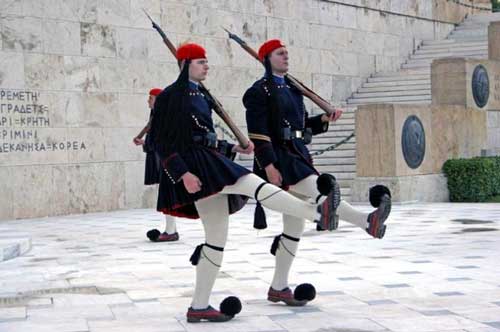
Modern Greek Evzones Changing guards at the tomb of the unknown soldier
The basic elements of the uniform are:
- The phareon, a scarlet garrison cap with a long black tassel.
- A fustanella kilt.
- White stockings.
- Black garters.
- Red tsarouhi clogs.
- A leathern cartridge belt and M1 Garand semi-automatic battle rifle, with bayonet.
The basic color of the winter uniform is navy blue, while the summer uniform is khaki. The full-dress uniform, worn at the reception of foreign dignitaries, on important national holidays and other special occasions is pure white, with the addition of a fancy gold-brocade waistcoat. Members of the guard can also sometimes be seen in a royal blue and red uniform based on the traditional male costume of Crete, or in the black traditional habit once worn by the Greeks of Pontus. The officers are armed with a sabre instead of a rifle. The phareon is similar to the fez adopted by the Ottomans which were the main enemies of the evzones.
The uniforms of officers are distinguished from those of enlisted men by the substitution of red buskins for the stockings, and blue garters, their fustanella kilts are also longer than those of the enlisted Evzones.
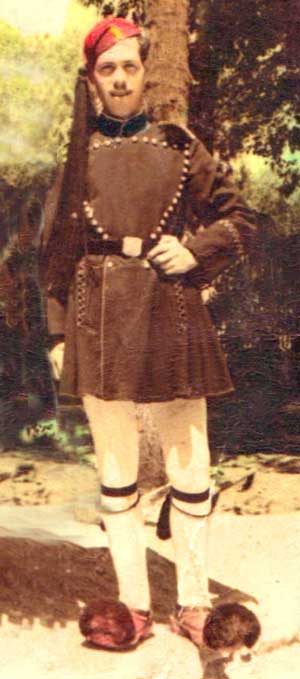
Evzonas, Alexandros Daskalakis.
Notable Evzones officers
Dimitrios Psaros
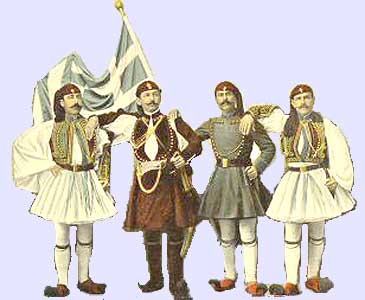
| Ancient Greece
Science, Technology , Medicine , Warfare, , Biographies , Life , Cities/Places/Maps , Arts , Literature , Philosophy ,Olympics, Mythology , History , Images Medieval Greece / Byzantine Empire Science, Technology, Arts, , Warfare , Literature, Biographies, Icons, History Modern Greece Cities, Islands, Regions, Fauna/Flora ,Biographies , History , Warfare, Science/Technology, Literature, Music , Arts , Film/Actors , Sport , Fashion --- |
Retrieved from "http://en.wikipedia.org/"
All text is available under the terms of the GNU Free Documentation License

